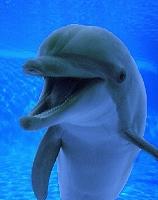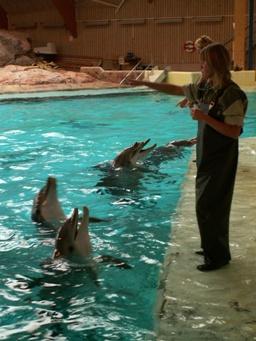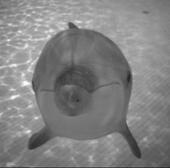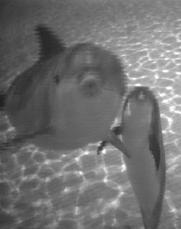Acoustic enrichment for dolphins in a pool environment
- Click on picture to go directly to the Final Thesis -
For ideas for acoustic enrichment, see Conclusions and Recommendations.

The Bottlenose Dolphin
The bottlenose dolphin (Tursiops truncatus) has an advanced broadband sonar system based on trains of short click sounds, in which the intensity, power spectrum and click repetition rate can be considerably varied. In the wild, sonar is used primarily for navigation, foraging and hunt. The bottlenose dolphin inhabits coastal waters and estuaries but can travel long distances over the open sea. They are skilled hunters and can dive down to depths of 600 m while foraging. They are known to use bottom structures such as underwater ridges and reefs for navigation when travelling over wide areas. These kinds of orientation references will further be referred to as landmarks.

Sonar use in a pool
In whale and dolphin exhibits around the world, an artificial setting (i.e. pool environment) is the most common mode of display. The bare and static environment in a pool, does not provide many acoustic challenges for echolocating dolphins. A pool often has sufficient lighting, clear water and limited amount of obstacles, which enables dolphins to navigate solely using vision. For health and safety reasons the dolphins are usually hand fed dead fish, which reduces the need for hunt.
The Zoo Community
There is a growing demand on the zoo community from visitors, international animal welfare organizations, in some countries legal requirements, but to an increasing extent from the zoo community itself, to have natural exhibits and environmental enrichment implemented to improve animal welfare.
The Purpose of this Study
In this study enrichment objects intended to encourage natural behavior activities associated with sonar use was introduced in a pool holding twelve bottlenose dolphins. The study was conducted at Kolmården Dolphinarium , Sweden.
To read more about the project please click on the picture.
This study was carried out by Malin Berglind


Responsible for this page:
Director of undergraduate studies Biology
Last updated:
09/22/05





